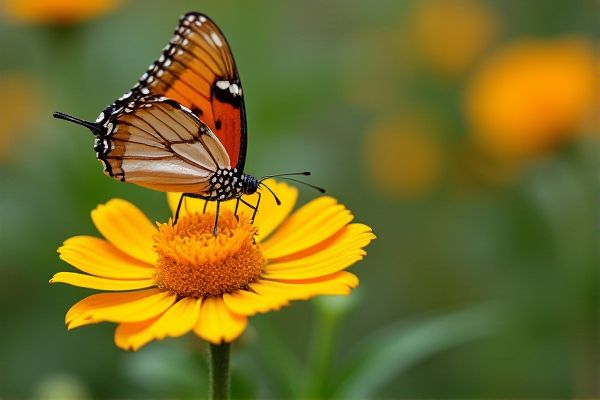
A butterfly garden is designed to attract and support butterflies by providing nectar-rich flowers and host plants for caterpillars, while a bee garden focuses on pollinator-friendly plants that supply pollen and nectar to sustain various bee species. Explore the rest of this article to discover how you can create a vibrant habitat that best suits your garden's needs and supports local ecosystems.
Table of Comparison
| Feature | Butterfly Garden | Bee Garden |
|---|---|---|
| Primary Pollinators | Butterflies (e.g., Monarch, Swallowtail) | Bees (e.g., Honeybee, Bumblebee) |
| Plant Selection | Nectar-rich flowering plants like Milkweed, Buddleia | Pollen and nectar plants like Clover, Lavender, Sunflowers |
| Purpose | Attracts butterflies for pollination and visual appeal | Supports bee population and enhances pollination of crops |
| Habitat Requirements | Sunny areas with shelter and host plants for caterpillars | Varied habitats with nesting sites, open flowers, and water source |
| Maintenance | Regular pruning, avoiding pesticides | Providing diverse flowering periods, avoiding insecticides |
| Ecological Benefits | Enhances biodiversity, supports butterfly life cycle | Boosts pollination, supports bee populations, improves crop yields |
Introduction to Butterfly Gardens vs Bee Gardens
Butterfly gardens are designed to attract and support a variety of butterfly species by providing nectar-rich flowers and host plants for larvae, promoting pollinator diversity and ecological balance. Bee gardens focus on creating habitats for solitary and social bees through native flowering plants and nesting sites, enhancing urban biodiversity and honey production. Your choice between a butterfly garden and a bee garden depends on whether you wish to support conservation efforts for butterflies or improve pollination and honey yield by fostering bee populations.
Key Differences Between Butterfly and Bee Gardens
Butterfly gardens are designed to attract specific nectar-rich flowers that provide food and breeding habitats for butterflies, while bee gardens prioritize a diverse range of native flowering plants that support various bee species through pollen and nectar sources. Butterfly gardens often feature milkweed and butterfly bush, essential for caterpillar development, whereas bee gardens emphasize plants like lavender, sunflowers, and clover that boost pollinator health and biodiversity. Your garden choice impacts local ecosystems differently, as butterfly gardens support butterfly populations and visual appeal, whereas bee gardens enhance pollination efficiency and contribute to sustainable agriculture.
Essential Plants for Butterfly Gardens
Essential plants for butterfly gardens include native milkweed, coneflowers, and lantana, which provide nectar sources and host plants for caterpillars, promoting butterfly life cycles. These plants attract diverse butterfly species by offering continuous blooming periods and suitable habitats for breeding. Compared to bee gardens that prioritize pollen-rich flowers like lavender and sunflowers, butterfly gardens focus on plants that support every stage of butterfly development.
Essential Plants for Bee Gardens
Essential plants for bee gardens include native wildflowers such as coneflowers, bee balm, and goldenrod, which provide abundant nectar and pollen throughout the growing season. Unlike butterfly gardens that often emphasize milkweed or nectar-rich flowering plants primarily attracting butterflies, bee gardens prioritize diverse blossoms that support both solitary and honeybee populations. Your bee garden thrives with a variety of blooming plants ensuring continuous food sources and habitats crucial for pollinator health and ecosystem balance.
Garden Design Tips: Attracting Butterflies vs Bees
Plant a diverse range of native flowering plants with overlapping bloom periods to attract butterflies, emphasizing nectar-rich flowers like milkweed and coneflowers, while arranging sunlit areas for basking. For bee gardens, incorporate a variety of pollen and nectar sources such as lavender, clover, and borage, providing nesting habitats like bare soil patches or bee houses to support solitary bees. Avoid pesticide use and ensure water sources are shallow and accessible to enhance both butterfly and bee attraction effectively.
Environmental Benefits: Butterflies vs Bees
Butterfly gardens enhance biodiversity by supporting pollinator species that contribute to the health of flowering plants, while bee gardens play a critical role in crop pollination and maintaining agricultural ecosystems. Bees generally provide more efficient pollination, essential for the production of fruits, vegetables, and nuts, directly impacting food security. Both gardens help sustain habitats, but bee gardens have a greater direct effect on environmental stability due to bees' higher pollination rates and broader plant interactions.
Maintenance Requirements for Each Garden Type
Butterfly gardens generally require regular maintenance, including frequent watering, deadheading flowers, and monitoring for pests to sustain nectar sources and host plants. Bee gardens demand less frequent upkeep but need a variety of native flowering plants to bloom throughout the seasons and minimal pesticide use to protect pollinators. Both garden types benefit from soil health management, but butterfly gardens often necessitate more active care to maintain a vibrant habitat.
Supporting Pollinator Populations: Butterflies vs Bees
Butterfly gardens provide critical nectar sources and host plants essential for butterfly lifecycles, promoting biodiversity and supporting species like monarchs and swallowtails. Bee gardens, by contrast, offer abundant pollen and diverse floral resources that sustain both honeybees and native pollinators, enhancing overall pollination efficiency and ecosystem health. While butterfly gardens primarily attract visual pollinators, bee gardens contribute more significantly to agricultural productivity due to bees' superior pollination capabilities.
Common Challenges in Butterfly and Bee Gardens
Butterfly and bee gardens both face common challenges such as habitat loss, pesticide exposure, and climate change impacting pollinator populations. Ensuring a continuous supply of native flowering plants is crucial to provide adequate nectar and pollen sources throughout the growing season. You should also address issues like invasive species that compete with native plants and maintain proper garden hygiene to reduce pests and diseases affecting both butterflies and bees.
Which Garden is Right for You: Butterfly or Bee?
Choosing between a butterfly garden and a bee garden depends on your environmental goals and space availability. Butterfly gardens, rich in nectar plants like milkweed and lantana, enhance pollination while offering vibrant visual appeal ideal for attracting diverse butterfly species. Bee gardens prioritize native flowering plants such as coneflowers and goldenrod, providing essential forage to support declining pollinator populations and boost local biodiversity.
 homyna.com
homyna.com